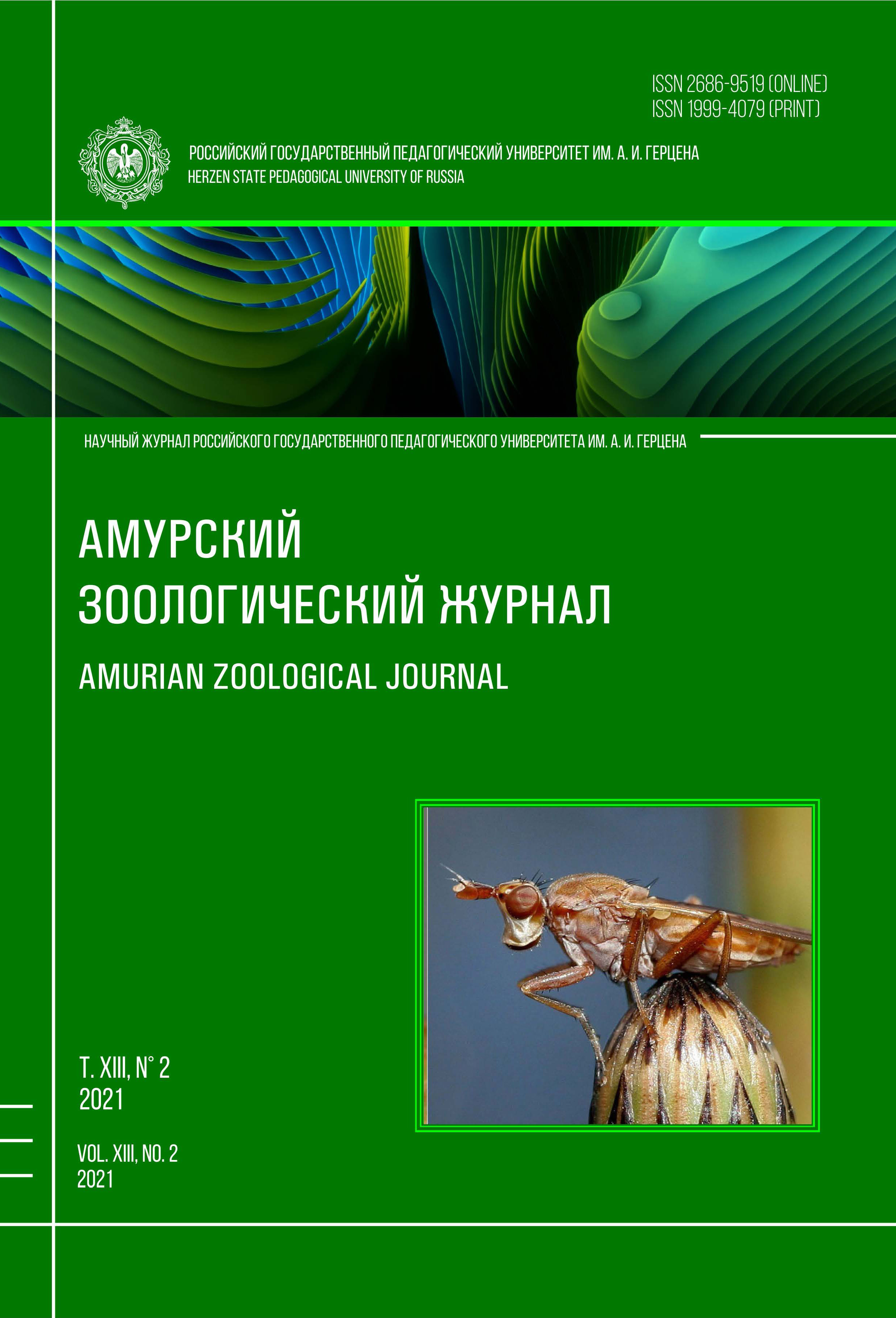The ecology and distribution of wild boars (Sus scrofa Linnaeus, 1758) in the foothills of the Martakert Region of the Republic of Artsakh
DOI:
https://doi.org/10.33910/2686-9519-2021-13-2-154-161Keywords:
wild boars, pigs, ecology, population, food competitors, range dynamics, artiodactyls, high fecundityAbstract
Up to this day, there is no reliable data on the ecology and biology of wild boars common in the fauna of the Republic of Artsakh. Given that wild boars are game animals, they are considered a vulnerable species. The paper presents the results of the first study in the ecology and distribution of wild boars in the foothill of the Martakert Region of the Republic of Artsakh. The territories for the study were not a random choice as they take into account both survival and stress factors. The study started in 1999 and is still on. The authors used environmental monitoring, camera traps and GPSmap 62stc to obtain data on the population, lifestyle, types of activity, ecology and biology of wild boars. The number of wild boars remains relatively stable, which is, most likely, due to their high fecundity. A massive reduction in the population of wild boars is driven by the spread of African plague, unregulated hunting, poaching, as well as deforestation and forest fires. Wild boars are mostly sedentary species. They are omnivores. The ratio of plant and animal food varies depending on the season and environmental conditions. Food competitors are represented by herbivorous mammals. Wild boars are prolific. The main danger to wild boars is posed by carnivorous mammals and humans.
References
ЛИТЕРАТУРА
Айрапетян, В. Т. (2014) Фауна млекопитающих Нагорно-Карабахской Республики. Диссертация на соискание ученой степени доктора биологических наук. Ереван, Национальная академия наук Республики Армения, 289 с.
Данилкин, А. А. (2002) Млекопитающие России и сопредельных регионов. Свиные. М.: ГЕОС, 309 с.
Новиков, Г. А. (1953) Полевые исследования по экологии наземных позвоночных. 2-е изд., испр. и доп. М.: Советская наука, 503 с.
Павлинов, И. Я. (1999) Природа России: жизнь животных. Млекопитающие. Ч. 1. Хищные. Копытные. М.: АСТ, 608 с.
Слудский, А. А. (1956) Кабан (Морфология, экология, хозяйственное и эпизоотологическое значение, промысел). Алма-Ата: Изд-во АН КазССР, 220 с.
Соколов, В. Е., Темботов, А. К. (1993) Млекопитающие, копытные. М.: Наука, 524 с.
Явруян, Э. Г., Айрапетян, В. Т. (2003) Дикие млекопитающие Карабаха (Хищные, копытные). Степанакерт: Дизак плюс, 48 с.
REFERENCES
Ajrapetyan, V. T. (2014) Fauna mlekopitayushikh Nagorno-Karabakhskoj Respubliki [Nagorno Karabakh Republic mammal’s Fauna]. PhD dissertation (Biology). Yerevan, National Academy of Sciences of Armenia, 289 p. (In Armenian).
Danilkin, A. A. (2002) Mlekopitayushchie Rossii i sopredel’nykh regionov. Svinye [The mammals of Russia and adjacent regions. Suidae]. Moscow: GEOS Publ., 309 p. (In Russian)
Novikov, G. A. (1953) Polevye issledovaniya po ekologii nazemnykh pozvonochnykh [Field research on the ecology of terrestrial vertebrates]. 2nd ed., correct. and compl. Moscow: Sovetskaya nauka Publ., 503 p. (In Russian)
Pavlinov, I. Ya. (1999) Priroda Rossii: zhizn’ zhivotnykh. Mlekopitayushchie. Ch. 1. Khishchnye. Kopytnye [Nature of Russia: Animal life. Mammals. Pt 1. Carnivora. Ungulates]. Moscow: AST Publ., 608 p. (In Russian)
Sludskij, A. A. (1956) Kaban (Morfologiya, ekologiya, khozyajstvennoe i epizootologicheskoe znachenie, promysel) [Wild boar (Morphology, ecology, economic and epizootiological significance, trade)]. Almaty: Kazakhstan Academy of Sciences Publ., 220 p. (In Russian)
Sokolov, V. E. Tembotov, A. K. (1993) Mlekopitayushchie, kopytnye [Mammals, ungulates]. Moscow: Nauka Publ., 524 p. (In Russian)
Yavruyan, E. G., Ajrapetyan, V. T. (2003) Dikie mlekopitayushchie Karabakha (Khishnye, kopytnye) [Wild mammals of Nagorno Karabakh (Carnivora, ungulates)]. Stepanakert: Dizak Plus Publ., 48 p. (In Armenian)
Published
Issue
Section
License
Copyright (c) 2021 Vahram T. Hayrapetyan, Asmik Dzh. Minasyan

This work is licensed under a Creative Commons Attribution-NonCommercial 4.0 International License.
The work is provided under the terms of the Public Offer and of Creative Commons public license Creative Commons Attribution 4.0 International (CC BY 4.0).
This license permits an unlimited number of users to copy and redistribute the material in any medium or format, and to remix, transform, and build upon the material for any purpose, including commercial use.
This license retains copyright for the authors but allows others to freely distribute, use, and adapt the work, on the mandatory condition that appropriate credit is given. Users must provide a correct link to the original publication in our journal, cite the authors' names, and indicate if any changes were made.
Copyright remains with the authors. The CC BY 4.0 license does not transfer rights to third parties but rather grants users prior permission for use, provided the attribution condition is met. Any use of the work will be governed by the terms of this license.







